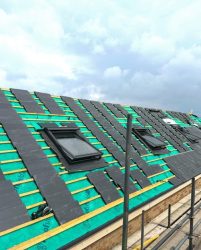
WATERPROOFING: THE FUTURE IS COLD
With water ingress a key factor in up to 75% of building failures post-construction, the waterproofing membrane is the first line of defence and so should be considered at the earliest possible stage in the design and build process. But faced with smaller budgets, tighter deadlines, health and safety concerns, and even more stringent building regulations, it’s vital to get the system selection and installation right first time.

From built-up felt systems to single-ply, hot melt to mastic asphalt, how can you be sure that your chosen waterproofing system will deliver proven performance and remain watertight in the long-term? With a proven track record and designed with an efficient installation process in mind, the cost-effective Cold Melt® liquid waterproofing system from Proteus Waterproofing is set to change perceptions for specifiers designing protected membrane, inverted or warm roof applications.
Combining long term performance, fast application and an unrivalled freedom of design, the Cold Melt® liquid roof system is ideal for virtually any roof application. The system can include inverted roof insulation and, with or without insulation, can be designed as a paved, ballasted, green or brown roof.
The devil is in the detail
Cold-applied systems offer other advantages over traditional types of waterproofing. As well as offering a ‘safer’ application, the liquid coating can be used to deliver a seamless finish as it forms a permanently elastic, seamless membrane. Ideal for the long-term waterproofing of complex roof details around pipes, upstands and gutters, the system is a popular specification at contemporary roofing projects where penetrations are becoming ever more prevalent.
“In recent years we have seen more and more projects requiring intricate detailing works around rooftop penetrations,” said Justin Pitman at Proteus Waterproofing. “Cold-applied systems also minimise the element of risk associated with torch-on applications.”
There are no naked flames or boilers involved at any time with the installation process and as it exhibits extremely low odour, Cold Melt® makes for a quick, simple and safe-to-apply waterproofing solution, particularly when you have an application in confined spaces such as balconies, walkways or hard-to-reach areas.
Green concrete time-saver
When inverted or protected roofing is installed over concrete, this can delay the building programme as in-situ concrete typically requires a minimum of 28 days to cure before building works can begin. Unlike other membranes, Cold Melt® can be applied over green concrete as early as three days after it has been installed which will add up to considerable time savings on a project.
Cold Melt® can also reduce the cost of the build. It may be more expensive than hot-melt systems, but in the long run, installation costs will bring the cost of the job down significantly. For example, a quote using the Cold Melt® System includes the flat waterproofing as well as the upstands and all the detailing in one price per square metre. With other systems, contractors might quote a lower price per square metre but this will only be for the flat waterproofing. There will then be an extra charge for all the other detailing on the job. So in the end, there will be little final differential cost between systems.
For specifiers wanting the durable, seamless and waterproof membrane of the future, then Cold Melt® is the answer. It will ultimately save money, is a speedy way of waterproofing and as it offers true versatility – this is the solution that will always come out on top, no matter what the challenge.





